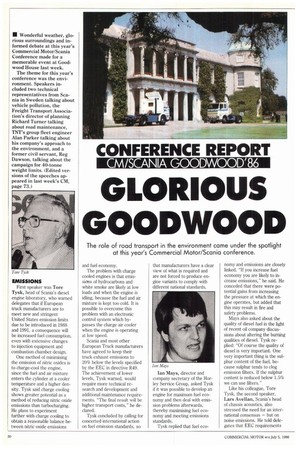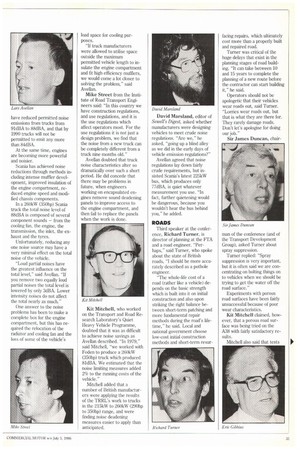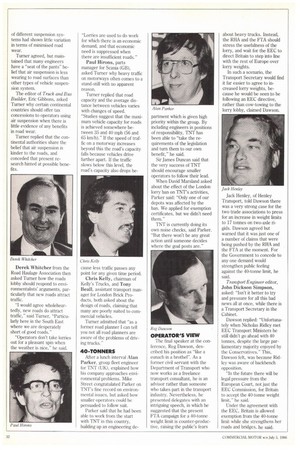GLORIOUS GOOD WOOD
Page 32

Page 33

Page 34

If you've noticed an error in this article please click here to report it so we can fix it.
The role of road transport in the environment came under the spotlight at this year's Commercial Motor/Scania conference.
• Wonderful weather, glorious surroundings and informed debate at this year's Commercial Motor/Scania Conference made for a memorable event at Goodwood House last week.
The theme for this year's conference was the environment. Speakers included two technical representatives from Scania in Sweden talking about vehicle pollution, the Freight Transport Association's director of planning Richard Turner talking about road maintenance, TNT's group fleet engineer Alan Parker talking about his company's approach to the environment, and a former civil servant, Reg Dawson, talking about the campaign for 40-tonne weight limits. (Edited versions of the speeches appeared in last week's CM, page 73.) EMISSIONS First speaker was Tore Tysk, head of Scania's diesel engine laboratory, who warned delegates that if European truck manufacturers are to meet new and stringent United States emission limits due to be introduced in 1988 and 1991, a consequence will be increased fuel consumption, even with extensive changes to injection equipment and combustion chamber design.
One method of minimising the emission of nitric oxides is to charge-cool the engine, since the fuel and air mixture enters the cylinder at a cooler temperature and a higher density. Tysk said charge cooling shows greater potential as a method of reducing nitric oxide emissions than turbocharging. He plans to experiment further with charge cooling to obtain a reasonable balance between nitric oxide emissions and fuel economy.
The problem with charge cooled engines is that emissions of hydrocarbons and white smoke are likely at low loads and when the engine is idling, because the fuel and air mixture is kept too cold. It is possible to overcome this problem with an electronic control system which bypasses the charge air cooler when the engine is operating at low speed.
Scania and most other European Truck manufacturers have agreed to keep their truck exhaust emissions to 20% below the levels specified by the EEC in directive R49. The achievement of lower levels, Tysk warned, would require more technical research and development and additional maintenance requirements. "The final result will be higher transport costs," he declared.
Tysk concluded by calling for concerted international action on fuel emission standards, so that manufacturers have a clear view of what is required and are not forced to produce engine variants to comply with different national standards.
Ian Mays, director and company secretary of the Horley Service Group, asked Tysk if it was possible to develop an engine for maximum fuel economy and then deal with emission problems afterwards, thereby maximising fuel economy and meeting emissions standards.
Tysk replied that fuel eco
nomy and emissions are closely linked. "If you increase fuel economy you are likely to increase emissions," he said. He conceded that there were potential gains from increasing the pressure at which the engine operates, but added that this may result in fire and safety problems.
Mays also asked about the quality of diesel fuel in the light of recent oil company discussions about altering the burning qualities of diesel. Tysk replied: "Of course the quality of diesel is very important. One very important thing is the sulphur content of the fuel, because sulphur tends to clog emission filters. If the sulphur content is reduced below 1.5% we can use filters."
Like his colleague, Tore Tysk, the second speaker, Lars AveIlan, Scania's head of chassis acoustics, also stressed the need for an international consensus — but on noise emissions. He told delegates that EEC requirements
have reduced permitted noise emissions from trucks from 91dBA to 88dBA, and that by 1990 trucks will not be permitted to emit any more than 84dBA.
At the same time, engines are becoming more powerful and noisier.
Scalia has achieved noise reductions through methods including intense muffler development, improved insulation of the engine compartment, reduced engine speed and modified chassis components.
In a 260kW (350hp) Scainia truck the total noise level of 88dBA is composed of several component sounds — from the cooling fan, the engine, the transmission, the inlet, the exhaust and the tyres.
Unfortunately, reducing any one noise source may have a very minimal effect on the total noise of the vehicle.
"Loud partial noises have the greatest influence on the total level," said Avellan. "If you remove two equally loud partial noises the total level is lowered by only 3dBA. Lower intensity noises do not affect the total nearly as much."
One answer to the noise problems has been to make a complete box for the engine compartment, but this has required the relocation of the radiator and cooling fan and the loss of some of the vehicle's load space for cooling purposes.
"If truck manufacturers were allowed to utilise space outside the maximum permitted vehicle length to insulate the engine compartment and fit high efficiency mufflers, we would come a lot closer to solving the problem," said Avellan.
Mike Street from the Institute of Road Transport Engineers said: "In this country we have construction regulations, and use regulations, and it is the use regulations which affect operators most. For the use regulations it is not just a design problem, we find that the noise from a new truck can be completely different from a truck nine months old."
Avellan doubted that truck noise characteristics alter so dramatically over such a short period. He did concede that there may be problems in future, when engineers working on encapsulated engines remove sound deadening panels to improve access to the engine compartment, and then fail to replace the panels when the work is done.
Kit Mitchell, who worked on the Transport and Road Research Laboratory's Quiet Heavy Vehicle Programme, doubted that it was as difficult to achieve noise savings as Avellan described, "In 1979," said Mitchell, "we worked with Foden to produce a 260kW (350hp) truck which produced 81dBA. We estimated that the noise limiting measures added 2% to the running costs of the vehicle."
Mitchell added that a number of British manufacturers were applying the results of the TRRL's work to trucks in the 215kW to 260kW (290hp to 350hp) range, and were finding noise deadening measures easier to apply than anticipated.
David Marsland, editor of Sewell's Digest, asked whether manufacturers were designing vehicles to meet crude noise regulations. "Are we," he asked, "going up a blind alley as we did in the early days of vehicle emission regulations?"
Avellan agreed that noise regulations lay down fairly crude requirements, but insisted Scania's latest 225kW bus, which produces only 77dBA, is quiet whatever measurement you use. "In fact, further quietening would be dangerous, because you wouldn't hear the bus behind you," he added.
Third speaker at the conference, Richard Turner, is director of planning at the FTA and a road engineer. "Perhaps," said Turner, who spoke about the state of British roads, "I should be more accurately described as a pothole engineer.
"The whole-life cost of a road (rather like a vehicle) depends on the basic strength which is built into it on initial construction and also upon striking the right balance between short-term patching and more fundamental repair methods during the road's lifetime," he said. Local and national government choose low-cost initial construction methods and short-term resur
facing repairs, which ultimately cost more than a properly built and repaired road.
Turner was critical of the huge delays that exist in the planning stages of road building. "It can take between 10 and 15 years to complete the planning of a new route before the contractor can start building it," he said.
Operators should not be apologetic that their vehicles wear roads out, said Turner. "Lorries wear roads out, but that is what they are there for. They rarely damage roads. Don't let's apologise for doing our job."
Sir James Duncan, chair
man of the conference (and of the Transport Development Group), asked Turner about spray suppression.
Turner replied: "Spray suppression is very important, but it is often said we are concentrating on bolting things on to vehicles when we should be trying to get the water off the road surface."
Experiments with porous road surfaces have been fairly unsuccessful because of poor wear characteristics.
Kit Mitchell claimed, however, that a porous road surface was being tried on the A38 with fairly satisfactory results.
Mitchell also said that tests
of different suspension systems had shown little variation in terms of minimised road wear.
Turner agreed, but maintained that many engineers have a "seat of the pants" belief that air suspension is less wearing to road surfaces than other types of vehicle suspension system.
The editor of Truck and Bus Builder, Eric Gibbons, asked Turner why certain continental countries should offer tax concessions to operators using air suspension when there is little evidence of any benefits in road wear.
Turner replied that the continental authorities share the belief that air suspension is kinder to the roads, and conceded that present research hinted at possible benefits.
Derek Whitcher from the Road Haulage Association then asked Turner how the roads lobby should respond to environmentalists' arguments, particularly that new roads attract traffic.
"I would agree wholeheartedly, new roads do attract traffic," said Turner, "Particularly here in the South East where we are desperately short of good roads."
"Operators don't take lorries out for a pleasant spin when the weather is nice," he said. "Lorries are used to do work for which there is an economic demand, and that economic need is suppressed when there are insufficient roads."
Paul Hirons, parts manager for Scania (GB), asked Turner why heavy traffic on motorways often comes to a stand-still with no apparent reason.
Turner replied that road capacity and the average distance between vehicles varies with changes of speed. "Studies suggest that the maximum vehicle capacity for roads is achieved somewhere between 35 and 40 mph (56 and 65 km/h)." If the speed of traffic on a motorway increases beyond this the road's capacity falls because vehicles drive further apart. If the traffic slows below this level, the road's capacity also drops be cause less traffic passes any point for any given time period.
Chris Kelly, chairman of Kelly's Trucks, and Tony Beall, assistant transport manager for London Brick Products, both asked about the design of roads, claiming that many are poorly suited to commercial vehicles.
Turner admitted that "as a former road planner I can tell you not all road planners are aware of the problems of driving trucks."
After a lunch interval Alan Parker, group fleet engineer for TNT (UK), explained how his company approaches environmental problems. Mike Street congratulated Parker on TNT's fine record on environmental issues, but asked how smaller operators could be persuaded to follow suit.
Parker said that he had been able to work from the start with TNT in this country, building up an engineering de
partment which is given high priority within the group. By including engineers in positions of responsibility, TNT has been able to "take the requirements of the legislation and turn them to our own benefit," he said.
Sir James Duncan said that the very success of TNT should encourage smaller operators to follow their lead.
When David Marsland asked about the effect of the London lorry ban on TNT's activities, Parker said: "Only one of our depots was affected by the ban. We applied for exemption certificates, but we didn't need them."
TNT is currently doing its own noise checks, said Parker. "But there won't be any great action until someone decides where the goal posts are."
OPERATOR'S VIEW
The final speaker at the conference, Reg Dawson, described his position as "like a eunach in a brothel". As a former civil servant with the Department of Transport who now works as a freelance transport consultant, he is an advisor rather than someone who takes part in the transport industry. Nevertheless, he presented delegates with an intriguing speech, in which he suggested that the present PTA campaign for a 40-tonne weight limit is counter-productive, raising the public's fears
about heavy trucks. Instead, the RHA and the FFA should stress the usefulness of the lorry, and wait for the EEC to direct Britain to step into line with the rest of Europe over lorry weights.
In such a scenario, the Transport Secretary would find it far easier to agree to increased lorry weights, because he would be seen to be following an EEC directive, rather than cow-towing to the lorry lobby, claimed Dawson.
Jack Henley, of Henley Transport, told Dawson there was a very strong case for the two trade associations to press for an increase in weight limits to 17 tonnes on two-axle rigids. Dawson agreed but warned that it was just one of a number of claims that were being pushed by the RHA and the FTA at the moment. For the Government to concede to any one demand would strengthen public feeling against the 40-tonne limit, he said.
Transport Engineer editor, John Dickson Simpson, asked: "Isn't it better to try and pressure for all this bad news all at once, while there is a Transport Secretary in the Cabinet.
Dawson replied: "Unfortunately when Nicholas Ridley met EEC Transport Ministers he still didn't go ahead with 40 tonnes, despite the large parliamentary majority enjoyed by the Conservatives." This, Dawson felt, was because Ridley was aware of backbench opposition.
"In the future there will be legal pressure from the European Court, not just the EEC Commission, for Britain to accept the 40-tonne weight limit," he said.
Under the agreement with the EEC, Britain is allowed exemption from the 40-tonne limit while she strengthens her roads and bridges, he said.




































































































